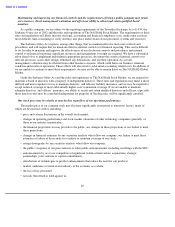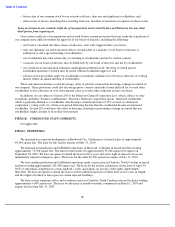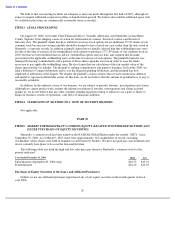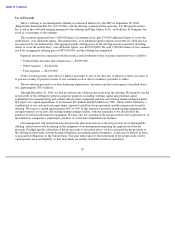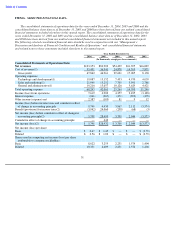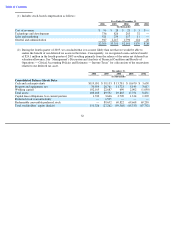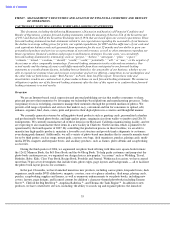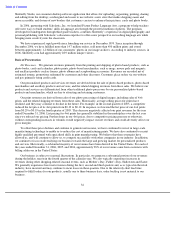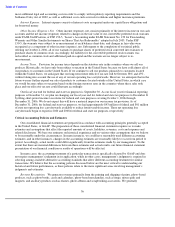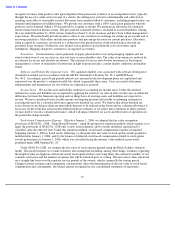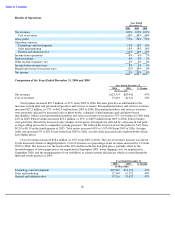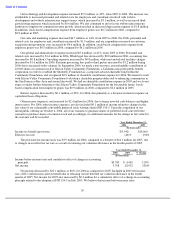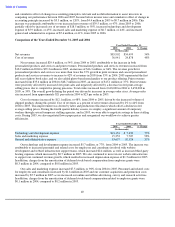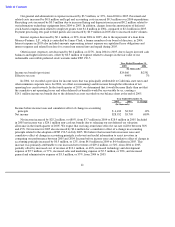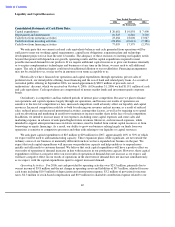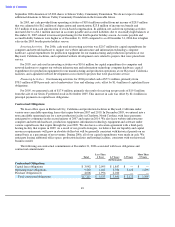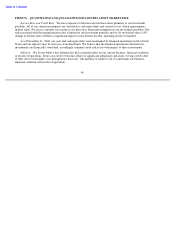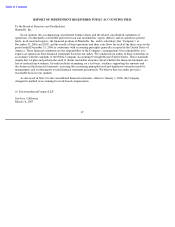Shutterfly 2007 Annual Report Download - page 42
Download and view the complete annual report
Please find page 42 of the 2007 Shutterfly annual report below. You can navigate through the pages in the report by either clicking on the pages listed below, or by using the keyword search tool below to find specific information within the annual report.
Table of Contents
recognize revenues from product sales upon shipment when persuasive evidence of an arrangement exists (typically
through the use of a credit card or receipt of a check), the selling price is fixed or determinable and collection of
resulting receivables is reasonably assured. Revenues from amounts billed to customers, including prepaid orders, are
deferred until shipment of fulfilled orders. We provide our customers with a 100% satisfaction guarantee whereby
products can be returned within a 30-day period for a reprint or refund. We maintain an allowance for estimated
future returns based on historical data. The provision for estimated returns is included in accrued liabilities. During
the year ended December 31, 2006, returns totaled less than 1% of net revenues and have been within management’s
expectations. We periodically provide incentive offers to our customers in exchange for setting up an account and to
encourage purchases. Such offers include free products and percentage discounts on current purchases. Discounts,
when accepted by customers, are treated as a reduction to the purchase price of the related transaction and are
presented in net revenues. Production costs related to free products are included in costs of revenues upon
redemption. Shipping charged to customers is recognized as revenues.
Inventories. Our inventories consist primarily of paper, photo book covers and packaging supplies and are
stated at the lower of cost on a first-in, first-out basis or net realizable value. The value of inventories is reduced by
an estimate for excess and obsolete inventories. The estimate for excess and obsolete inventories is based upon
management’s review of utilization of inventories in light of projected sales, current market conditions and market
trends.
Software and Website Development Costs. We capitalize eligible costs associated with software developed or
obtained for internal use in accordance with the AICPA Statement of Position No. 98-1 and EITF Issue
No. 00
-2. Accordingly, payroll and payroll-related costs incurred in the development phase are capitalized and
amortized over the product’s estimated useful life, which is generally three years. Costs associated with minor
enhancements and maintenance for our website are expensed as incurred.
Income Taxes. We use the asset and liability method of accounting for income taxes. Under this method,
deferred tax assets and liabilities are recognized by applying the statutory tax rates in effect in the years in which the
differences between the financial reporting and tax filing bases of existing assets and liabilities are expected to
reverse. We have considered future taxable income and ongoing prudent and feasible tax planning strategies in
assessing the need for a valuation allowance against our deferred tax assets. We believe that all net deferred tax
assets shown on our balance sheet are more likely than not to be realized in the future and no valuation allowance is
necessary. In the event that actual results differ from those estimates or we adjust those estimates in future periods,
we may need to record a valuation allowance, which will impact deferred tax assets and the results of operations in
the period the change in made.
Stock-based Compensation Expense. Effective January 1, 2006, we adopted the fair value recognition
provisions of SFAS No. 123R, “Share-Based Payment,”
using the prospective transition method, which requires us to
apply the provisions of SFAS No. 123R only to new awards granted, and to awards modified, repurchased or
cancelled, after the effective date. Under this transition method, stock-based compensation expense recognized
beginning January 1, 2006 is based on the following: (a) the grant-date fair value of stock option awards granted or
modified after January 1, 2006; and (b) the balance of deferred stock-based compensation related to stock option
awards granted prior to January 1, 2006, which was calculated using the intrinsic value method as previously
permitted under APB Opinion No. 25.
Under SFAS No 123R, we estimate the fair value of stock options granted using the Black-Scholes valuation
model. This model requires us to make estimates and assumptions including, among other things, estimates regarding
the length of time an employee will retain vested stock options before exercising them, the estimated volatility of our
common stock price and the number of options that will be forfeited prior to vesting. The fair value is then amortized
on a straight-line basis over the requisite service periods of the awards, which is generally the vesting period.
Changes in these estimates and assumptions can materially affect the determination of the fair value of stock-based
compensation and consequently, the related amount recognized in our consolidated statements of operations.
37


